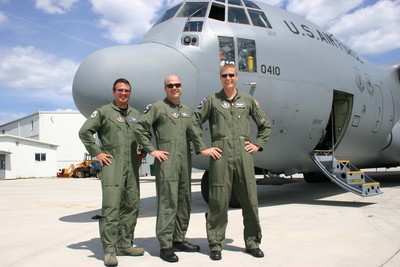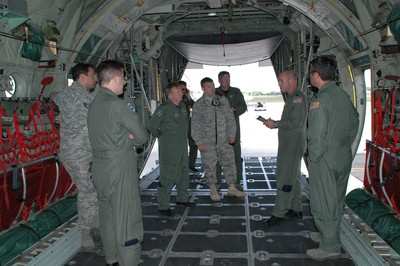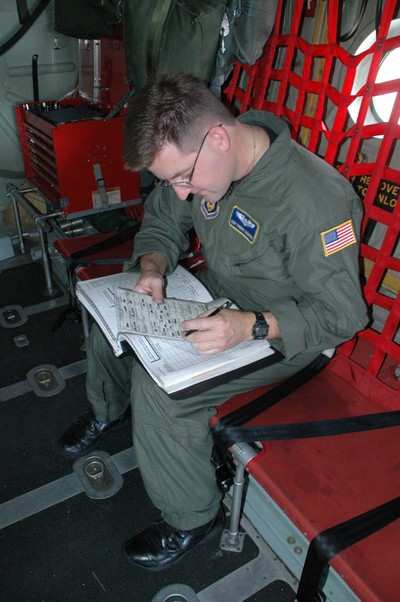440th Airlift Wing Airmen Developed Plan Still Used Today
Almost three years have passed since the 440th Airlift Wing at
Pope Air Force Base in North Carolina started flying Integrated
CONUS Medical Operations Plan (ICMOP) missions.

In late 2005, Col. Jay Flournoy and Lt. Colonels Bobby Oates,
Jeff Paulus and Dennis Beatty, all 440th Airmen, drew up a plan
that would use the talents of the 95th Airlift Squadron Reserve
aircrews returning from overseas activations in support of the
Global War on Terror. The plan involved a strategic agreement with
the Tanker Airlift Control Center for the wing to fly the missions.
The initial plan was so successful that TACC expanded the effort
and made agreements with other Reserve and Guard
units.
ICMOP was originally designed to get injured service members
home as quickly as possible after arriving in the United States
from overseas. Most of the returning patients are injured service
members supporting Operations Iraqi/Enduring Freedom. 440th crews
continue to fly a steady flow of those returning wounded soldiers
back home to locations around the country.
Lt. Col. Rick Larson, a 95th AS navigator with 24 years of
service, estimates 80 percent of the 440th’s TACC missions
are in support of ICMOP. He said these missions provide some of his
most memorable flying moments.
"These patients are courageous," he said, recalling injuries
ranging from explosive burns to amputations. "At times it can be
frightening when you see the devastating injuries, but we have an
amazing level of sophistication in the military medical corps."

Lt. Col. Larson said the most gratifying part of the
wounded warrior flights is the reunion of family members with
soldiers after a serious injury.
"There are always tears, smiles, hugs and sighs of relief," he
said.
The medical missions’ success depends on Active Duty and
Reserve aeromedical Airmen who take care of patients in the back of
the aircraft during the flight. A typical aeromedical crew is
comprised of seven Airmen. If duty calls, the loadmasters step in
and help.
"The patients’ stories are compelling," said Senior Master
Sgt. Dan Hirn, a 95th AS loadmaster entering his third year of TACC
mission support. "I remember one patient was a young kid from
Georgia. He was a Katrina refugee... his family had lost everything
during the hurricane... so he joined the Air Force for a new life
and then an IED (improvised explosive device) blew his foot off.
But he still had a positive attitude."
Sergeant Hirn was moved enough to keep in touch with the young
soldier. He said loadmasters see all kinds of patients, and
it’s not unusual for the ‘loads’ to assist with
on-loading and off-loading of patients.
"Sometimes we are the only direct communication between the
medical crews and the aircrew flying the plane," he said. "When we
have a patient go into respiratory distress, we need to let the
rest of the aircrew know so they can make alternate landing plans
if necessary."
Sergeant Hirn estimates he has flown more than 100 TACC missions
in the last two years. Although eligible for retirement, the farmer
from Wisconsin was recently given a one-year extension to continue
on the TACC missions.
The 440th’s role supporting TACC missions includes more
than ICMOP. The 95th Airlift Squadron also flies presidential
support missions and Joint Airborne/Air Transportability Training
missions.
Lt. Col. Dave Polachek, 95th AS pilot, said a JAATT mission was
his most memorable TACC work. "We were supporting the basic
airborne course at Fort Benning, Ga., at the basic airborne
training school Lawson Army Air Field," he said. "The other C-130
was down for maintenance, and this meant we had to fly the missions
of two aircraft with one plane."
For more than 12 hours, Colonel Polachek’s crew flew JAATT
missions nonstop, with "quick turns" between dropping up to 55
paratroopers at a time. They would pick up soldiers, airdrop the
paratroopers, fly to the drop zone, pick up more troopers, and
repeat it all again for a total of 13 sorties.
"We dropped more than 715 soldiers that day," he said. "These
soldiers were training to be airborne rangers, special ops and
other critical roles. Most of them were headed to the AOR in the
coming months." The crew dropped a total of 1,735 troops in three
days and they were awarded a certificate of appreciation and a
challenge coin from the Army commander of the airborne course.
Staff Sgt. Garrett Campbell, a 440th Maintenance Squadron
electrician, said his most memorable flight was involved a
4-month-old baby on a heart and lung machine.

"You have no idea where TACC missions will take you," he
explained. "Last spring we had a mission that took us to
Greensville, SC, where we picked up the baby. We flew the baby to
Lackland AFB in Texas. There were more than 30 people on that
flight trying to help this little baby make it. The last I heard,
the baby was doing great. Now that’s an exciting
mission."
During the last year, 440th crews have seen an increase in TACC
missions involving presidential support. During these "Phoenix
Banner" missions, the crews haul limousines, secret service agents
and armored vehicles as part of advance presidential party
support.
"The success of the TACC flights is due entirely to the efforts
of all the individuals who fly and support the missions," said Lt.
Col. Stephen Chafe, a pilot who directs many TACC missions. "To
date, more than sixty 440th Airmen have supported the mission. This
includes flight crew, maintainers, life support, and administrative
specialists."
(Aero-News salutes Lt. Col. Ann Peru Knabe, 440th Airlift
Wing Public Affairs)
 ANN's Daily Aero-Term (04.24.24): Runway Lead-in Light System
ANN's Daily Aero-Term (04.24.24): Runway Lead-in Light System ANN's Daily Aero-Linx (04.24.24)
ANN's Daily Aero-Linx (04.24.24) Aero-FAQ: Dave Juwel's Aviation Marketing Stories -- ITBOA BNITBOB
Aero-FAQ: Dave Juwel's Aviation Marketing Stories -- ITBOA BNITBOB Classic Aero-TV: Best Seat in The House -- 'Inside' The AeroShell Aerobatic Team
Classic Aero-TV: Best Seat in The House -- 'Inside' The AeroShell Aerobatic Team Airborne Affordable Flyers 04.18.24: CarbonCub UL, Fisher, Affordable Flyer Expo
Airborne Affordable Flyers 04.18.24: CarbonCub UL, Fisher, Affordable Flyer Expo





